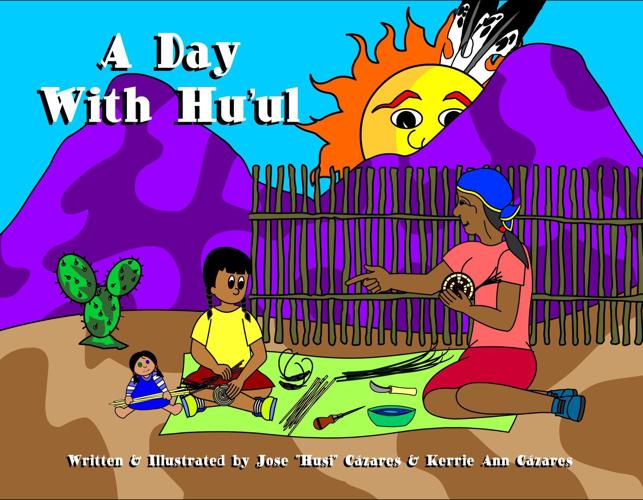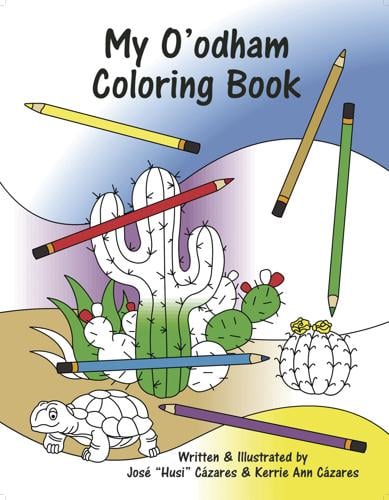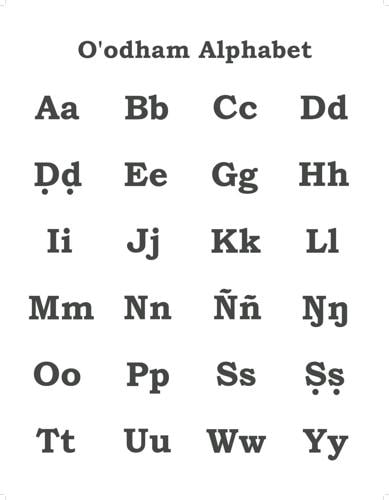In O’odham the word for goat is siwat and ce:kol is squirrel. The word for brain is ‘uag. Wanna know the O’odham word for pencil? It’s la:bis.
And hu’ul is the O’odham word for maternal grandmother, as in a new children’s picture book called “A Day With Hu’ul,” written and illustrated by José “Husi” Cázares and Kerrie Ann Cázares.
The book is one of two new publications created and published by the couple — the other is “My O’odham Coloring Book” — aimed at O’odham youth to encourage them to learn and maintain their language and himdag, the O’odham way of life and tradition. The books, including their previous publications, are one of a kind.
“There’s no template for this kind of stuff,” said José. To which Kerrie Ann added, “So we’re doing it our way.”
Their way began 10 years ago when the couple created their first coloring book, “T-O’odham A-B-C O’ohana.” It grew out of necessity, they said. Sadly, language arts resources for O’odham children is lacking.
The coloring book was a personal project for the Cázares. When they sold out the initial run of 500 copies, the couple realized there was a need and a demand among the 14 schools in and around the Tohono O’odham Nation, which is about the size of Connecticut.
There are seven reservations in central and southern Arizona, including villages in northern Mexico. The largest is the Tohono O’odham reservation, west of Tucson.
A second run of the “T-O’odham A-B-C O’ohana” coloring book came out in 2011, followed by another coloring book, “O’odham Mamasdagĭ O’ohana” in 2012 and their first hardback story book, “Lessons From Hu’ul Ke:li” in the same year.
With the publication of each book and increased number of printed copies — they printed 5,000 of their most recent book — the Cázares said their confidence grew, as did their determination to bring fresh ideas and images to O’odham children.
“All of the schools jumped on it,” they said. The story and coloring books are also in Pima County’s public library system.
“My O’odham Coloring Book,” lists the 24 letters in the O’odham alphabet, a pronunciation guide and names of colors. For each letter there are three images and the O’odham words for each. In the story book — based on José’s Hu’ul, Catherine Josemaria, who passed away in March 2006 at the age of 87 — O’odham words and the their corresponding English words are highlighted.
The story celebrates O’odham culture as the young girl and her Hu’ul engage in several traditional activities: gathering bahidag (saguaro cactus fruit) and ciolim (cholla buds), making cecemit (tortillas), cooking mu:ñ (pinto beans) or playing on the toka field, a game similar to field hockey.
“It is a game that comes from our people, and it belongs to us, the O’odham women. Only women play this game. Not even your Grandfather and the other men can play it,” Hu’ul says.
The Cázares, who live in northwest Tucson, bring their own perspectives to their work.
José grew up in the Tohono O’odham village of Pisin Moʼo, about 45 minutes west of Sells, the Nation’s capital. It was a traditional upbringing among sisters and other family members.
After high school he attended Pima Community College and the University of Arizona where he earned an undergraduate degree in speech pathology. He also completed two master’s degrees in Communication Sciences & Disorders from Saint Xavier University in Chicago and in American Indian Studies at the UA where he met Kerrie Ann, who is originally from the Chicago area.
She earned a bachelor’s degree in sociology at Xavier and has delved into learning O’Odham language and culture.
In addition to working as a speech pathologist, José teaches O’odham culture for the Tohono O’odham Community College.
They have seven children, and both are illustrators, work in graphic arts and web design. They also work as consultants.
To help expand their reach, the Cázares have a Facebook page, O’odham Stuff, where they post an O’odham word for the day, and a website hoodhamstuff.com, which carries additional information on O’odham culture.
The Cázares are doing this out of love for the O’odham culture and dedication to maintaining it. They’re not in it for the money. It’s pro bono work.
“Our compensation is that we’re treated as elders and with respect,” says Jose.







